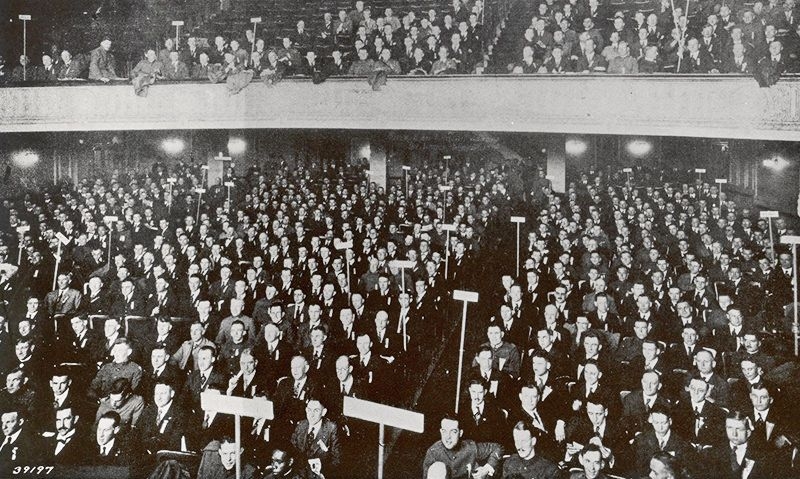
A three-day gathering in St. Louis May 8-10, 1919, drew more than 1,100 veterans of the Great War to the nation’s heartland to formalize what would become the nation’s largest organization of wartime veterans.
A century later, May 9-10, 2019, American Legion National Commander Brett P. Reistad will join hundreds of his fellow Legionnaires for ceremonies to commemorate the 100th anniversary of the St. Louis Caucus. Following a Thursday evening reception at the Soldiers Memorial Military Museum in downtown St. Louis, where American Legion centennial exhibits are on display, the public is invited to a Friday ceremony starting at 10 a.m. Reistad is the keynote speaker, American Legion Past National Commander and 100th Anniversary Observance Committee Chairman David K. Rehbein will discuss the history of the St. Louis Caucus, and visitors will be led by Department of Missouri Past Department Commander Charles Goodin to the nearby American Legion monument where wreaths will be placed and the contents of a time capsule shared. A luncheon follows Friday at the Missouri Athletic Club, which holds a unique place in the history of the Legion.
The 1919 St. Louis Caucus produced the Preamble to The American Legion Constitution that Hamilton Fish, chairman of the committee that drafted it, later said “should unite all Americans regardless of party.”
Inclusivity – the long-held value that a veteran is a veteran, regardless of politics, race, gender, tax status or rank at discharge – was established as policy at the St. Louis Caucus where Lt. Col. Theodore Roosevelt Jr. famously declined chants of support for him to lead the new organization. His reason: concern that the organization might appear politicized or partisan if he, the Republican son of a former U.S. president, were the first leader. “I want every American through the length and breadth of this land to realize that there is not a man in this caucus who is seeking anything for himself, personally, but that he is simply working for the good of the entire situation,” he said when declining the nomination, amid chants of “We want Teddy!”
Instead, the Democratic former mayor of Dallas, Henry D. Lindsley, was named chairman to lead the organization until a national commander could be elected at the first national convention in November in Minneapolis. The St. Louis Caucus also made permanent the name “American Legion.”
Veteran delegates and other attendees of the 1919 caucus included lawyers, newspaper editors, students, lumberjacks, railroad workers, doctors, farmers and pipefitters. They ranged in rank from privates to generals. Former Sgt. Jack Sullivan, who was elected vice chairman of the new organization, put it this way: “I am just a doughboy from Seattle, but I want to tell you that the enlisted man in the Army believes that every man who wore the khaki and the blue belongs to this great fraternity, and the common password to our action is, ‘the red, the white and the blue,’ whether he be a general, a commander, or a boy in the ranks.”
At the end of the St. Louis Caucus’ first day, delegates were invited to a reception at the Missouri Athletic Club put on by the Confederate Veterans, the Grand Army of the Republic (Union veterans) and the United Spanish War Veterans, organizations that had been designed to disappear when the last of their members passed away. The invitation from the veterans groups of past wars was a sign that the new American Legion was welcomed, and would take the baton into a new future of veterans advocacy.
Soon after the St. Louis Caucus, Roosevelt Jr., former Chaplain John W. Inzer of Alabama and John Herbert of Massachusetts began a nationwide tour, talking with former participants of pre-war civilian training camps in various states, lining up leaders who would serve as the first American Legion department officers and encouraging veterans to apply for post charters.
By the end of the first year, more than 5,400 American Legion posts were chartered around the world that still operate today, and membership climbed to nearly 700,000.
